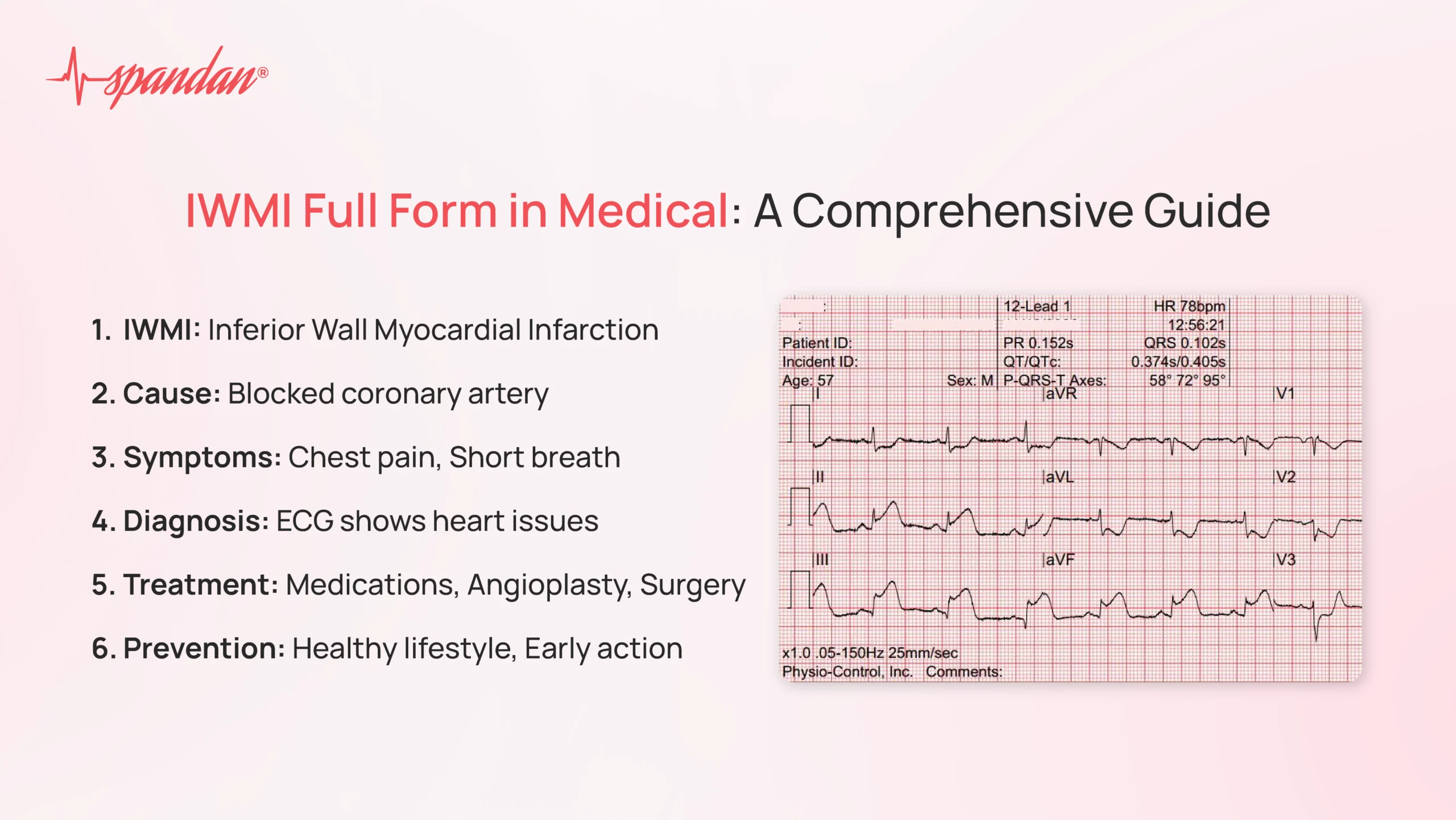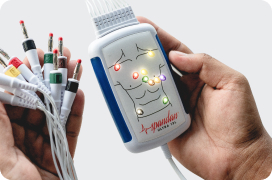
Related Article
Author:- Mr. Ritesh Sharma
When discussing heart attacks, medical professionals often use specific terminology to describe the affected area of the heart. One such term is “Inferior Wall Myocardial Infarction” (IWMI Full form in medical). This particular type of heart attack involves the lower part of the heart’s left ventricle and is associated with the right coronary artery. In this blog, we will explore the IWMI full form in medical terms, its causes, symptoms, diagnosis, treatment, and the importance of early intervention.
IWMI Full Form in Medical Terms
The IWMI full form in medical contexts is Inferior Wall Myocardial Infarction. This condition occurs when a blockage in the coronary arteries restricts blood flow to the inferior (lower) portion of the heart’s left ventricle. The right coronary artery is most commonly involved in this type of heart attack. When the blood supply is cut off, the affected heart muscle begins to die, leading to a myocardial infarction (heart attack).
Causes of Inferior Wall Myocardial Infarction
Understanding the causes behind an IWMI is crucial in both prevention and treatment. The IWMI full form in medical terms centers around the infarction, or blockage, in the coronary artery that supplies blood to the heart’s inferior wall. The main causes include:
- Atherosclerosis: The buildup of fatty deposits (plaque) in the coronary arteries, leading to narrowed or blocked arteries.
- Blood Clots: A sudden formation of a blood clot within a coronary artery can completely block blood flow to the heart muscle.
- Coronary Artery Spasm: A temporary spasm of a coronary artery that restricts blood flow, often triggered by stress, smoking, or stimulant drugs.
- Underlying Conditions: Conditions like hypertension, diabetes, and high cholesterol can increase the risk of developing an IWMI.
Symptoms of Inferior Wall Myocardial Infarction
Recognizing the symptoms of an IWMI can be lifesaving. The IWMI full form in medical scenarios refers to the heart attack itself, which presents with the following symptoms:
- Chest Pain: A sudden, intense pain or discomfort in the chest, often described as squeezing or pressure. This pain may radiate to the neck, jaw, back, or arms.
- Shortness of Breath: Difficulty breathing or feeling short of breath even at rest.
- Nausea and Vomiting: A feeling of sickness, often accompanied by vomiting.
- Diaphoresis: Excessive sweating, which may be cold and clammy.
- Dizziness or Lightheadedness: A feeling of being faint or unsteady, which may be accompanied by a loss of consciousness.
- Fatigue: Unusual and extreme tiredness that may come on suddenly.
These symptoms may vary in intensity and presentation, especially among women, elderly patients, and individuals with diabetes, who may experience atypical symptoms.
Diagnosis of Inferior Wall Myocardial Infarction
Timely and accurate diagnosis is critical in managing an IWMI. The IWMI full form in medical diagnostics involves several key steps:
- Electrocardiogram (ECG): The most crucial diagnostic tool, an ECG records the electrical activity of the heart. In an IWMI, the ECG typically shows ST-segment elevation in leads II, III, and aVF.
- Blood Tests: Blood tests measure cardiac enzymes such as troponin, which are released into the bloodstream when heart muscle is damaged.
- Echocardiogram: This imaging test uses sound waves to create detailed pictures of the heart, helping to identify areas of reduced motion in the inferior wall.
- Coronary Angiography: A more invasive test, angiography involves injecting a contrast dye into the coronary arteries to visualize blockages.
Treatment of Inferior Wall Myocardial Infarction
The treatment for an IWMI aims to restore blood flow to the heart as quickly as possible, minimizing heart muscle damage. The IWMI full form in medical treatment involves several approaches:
- Medications:
- Thrombolytics: These drugs dissolve blood clots and restore blood flow.
- Antiplatelet Agents: Medications like aspirin reduce the likelihood of clot formation.
- Anticoagulants: Blood thinners such as heparin help prevent further clotting.
- Beta-Blockers: These drugs reduce the heart’s workload and oxygen demand.
- Nitrates: Nitrates relax and widen blood vessels, improving blood flow to the heart.
- Percutaneous Coronary Intervention (PCI): Also known as angioplasty, this procedure involves threading a catheter with a balloon into the blocked artery. The balloon is then inflated to open the artery, and a stent is often placed to keep the artery open.
- Coronary Artery Bypass Grafting (CABG): In severe cases, bypass surgery may be necessary to create a new path for blood flow around the blocked artery.
- Lifestyle Modifications
: Post-treatment, patients are advised to make significant lifestyle changes, such as quitting smoking, adopting a heart-healthy diet, regular exercise, and managing stress, to prevent future heart attacks.
Importance of Early Intervention in IWMI
The IWMI full form in medical emergencies underscores the need for rapid intervention. Time is muscle—meaning the longer the heart muscle goes without oxygen, the more damage occurs. Early diagnosis and treatment significantly improve the prognosis for patients with an IWMI. Delays in treatment can lead to complications such as heart failure, arrhythmias, and an increased risk of death.
Prognosis and Recovery
The prognosis for an IWMI depends on the extent of the damage, the speed of treatment, and the patient’s overall health. With prompt treatment, many patients can recover well and resume normal activities. However, ongoing care and monitoring are essential to manage the risk of future heart events. Cardiac rehabilitation programs, which include supervised exercise, education on heart-healthy living, and counseling, can significantly improve recovery outcomes.
Understanding the Impact of IWMI
In conclusion, the IWMI full form in medical terms, Inferior Wall Myocardial Infarction, is a critical condition that requires immediate attention and treatment. This type of heart attack, affecting the lower part of the heart’s left ventricle, can have severe consequences if not managed promptly. By understanding the causes, symptoms, and treatment options for IWMI, patients and healthcare providers can work together to ensure the best possible outcomes.
Awareness and education about IWMI are vital for early recognition and intervention. As medical advancements continue, the prognosis for patients with IWMI improves, but the importance of timely care remains unchanged. Remember, if you or someone you know experiences symptoms of a heart attack, seek emergency medical help immediately—every second counts when dealing with an IWMI.




